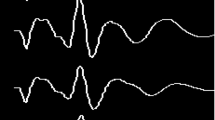Summary
Evoked acoustic emissions (EAEs) and spontaneous acoustic emissions (SAEs) recordings hold some promise as a fast, objective and non-invasive audiological procedure, especially in children. However, accurate interpretation in the emission response must be based on the basic properties of the emissions present in a younger age group. In so doing, the properties of emissions were investigated in 49 ears from 26 children, whose ages varied between 2 days and 10 years. EAEs could be recorded in all normal ears, but the incidence of long-duration EAEs decreased with age. There were no statistically significant variations in recording the EAEs detection threshold with age. The incidence of SAEs also decreased with age.
Similar content being viewed by others
References
Bonfils P, Uziel A (1989) Clinical applications of evoked acoustic emissions: results in normal and hearing loss subjects. Ann Oto-Rhino-Laryngol (in press)
Bonfils P, Bertrand Y, Uziel A (1988) Evoked otoacoustic emissions; normative data and prebycusis. Audiology 27:27–35
Bonfils P, Piron JP, Uziel A, Pujol R (1988) A correlative study of evoked otoacoustic emission properties and audiometric thresholds. Arch Otorhinolaryngol 245:53–56
Bonfils P, Uziel A, Narcy P (1988) Apport des emissioins acoustiques cochléaires en audiologie pédiatrique. Ann Otolaryngol (Paris) 105:109–113
Gold T (1948) Hearing. II. The physical basis of the action of the cochlea. Proc R Soc London B 135:492–498
Johnson NJ, Elberling C (1982) Evoked acoustic emissions from the human ear. II. Normative data in young adults and influence of posture. Scand Audiol 11:69–77
Johnson NJ, Bagi P, Elberling C (1983) Evoked acoustic emissions from the human ear. III. Findings in neonates. Scand Audiol 12:17–24
Kemp DT (1978) Stimulated acoustic emissions from within the human auditory system. J Acoust Soc Am 64:1386–1391
Probst R, Coats AC, Martin GK, Lonsbury-Martin BL (1986) Spontaneous, click- and tone-burst-evoked otoacoustic emissions from normal ears. Hear Res 21:261–275
Rabinowitz WM, Widin GP (1984) Interaction of spontaneous otoacoustic emissions and external sounds. J Acoust Soc Am 76:1713–1720
Strickland EA, Burns EM, Tubis A (1985) Incidence of spontaneous otoacoustic emissions in children and infants. J Acoust Soc Am 78:931–935
Wier CC, Norton SJ, Kincaid GE (1984) Spontaneous narrowband otoacoustic signals emitted by human ears: a replication. J Acoust Soc Am 76:1248–1250
Author information
Authors and Affiliations
Rights and permissions
About this article
Cite this article
Bonfils, P., Uziel, A. & Narcy, P. The properties of spontaneous and evoked acoustic emissions in neonates and children: a preliminary report. Arch Otorhinolaryngol 246, 249–251 (1989). https://doi.org/10.1007/BF00463565
Issue Date:
DOI: https://doi.org/10.1007/BF00463565



